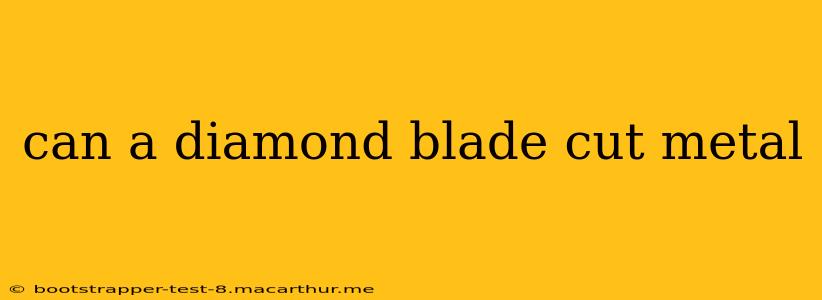Can a Diamond Blade Cut Metal? The Surprising Answer
The short answer is: yes, but with caveats. While diamond blades are renowned for their ability to cut through incredibly hard materials like stone and concrete, their effectiveness on metal depends heavily on several factors. It's not a simple yes or no, and understanding these nuances is crucial.
What Makes Diamond Blades Effective?
Diamond blades achieve their cutting power through the incredibly hard nature of diamonds themselves. These tiny diamond particles are embedded in a metal bond, creating a cutting edge capable of slicing through materials that would dull or destroy standard blades. The extreme hardness of diamond allows it to score and fracture even the toughest materials.
Can Diamond Blades Cut All Metals?
No. While some diamond blades can cut certain metals under specific conditions, they aren't universally effective. Their primary strength lies in cutting brittle materials. Metals, particularly ductile ones, present a different challenge.
What Types of Metal Can a Diamond Blade Cut?
Diamond blades are sometimes used to cut:
- Soft metals: Softer metals like aluminum and some alloys may be cut with a diamond blade, although a dedicated metal cutting blade would likely be more efficient and produce a cleaner cut.
- Thin metal sheets: Extremely thin sheets of metal might be cut with a diamond blade, though again, specialized tools would be preferable.
- Metal-embedded materials: Diamond blades are effective for cutting through materials that contain metal components, like reinforced concrete or ceramic tiles with metallic reinforcement. The blade cuts through the surrounding material, and the embedded metal is often severed as a consequence.
What Types of Metal Shouldn't Be Cut with a Diamond Blade?
Cutting most ferrous metals (like steel) with a diamond blade is generally not recommended. This is because:
- High risk of blade damage: The blade's diamond segments can become quickly worn or chipped. The metal's toughness and potential for deformation place significant stress on the blade, often leading to its premature failure.
- Potential for dangerous sparks: Cutting steel with a diamond blade can generate sparks, increasing the risk of fire or injury.
- Inefficiency: The process will be slow and inefficient compared to using a blade specifically designed for metal cutting.
What are the Alternatives for Cutting Metal?
For cutting metal, specialized blades are far superior. The optimal choice depends on the metal's type and thickness:
- Abrasive cut-off wheels: Excellent for various metals.
- Band saws: Suitable for intricate cuts and thicker materials.
- Plasma cutters: Ideal for thicker metals and precise cuts.
- Laser cutters: Offer highly precise and clean cuts, often used in industrial settings.
Why Wouldn't You Use a Diamond Blade to Cut Metal?
The most significant reason to avoid using a diamond blade on metal is the risk of severely damaging – or even destroying – the blade. Diamond blades are expensive; using them inappropriately represents a significant waste of resources. Furthermore, the potential for unsafe conditions, such as sparks and blade breakage, makes it a risky practice.
In Conclusion:
While a diamond blade might be able to cut through certain thin or soft metals in a pinch, it’s not its intended purpose, and doing so is highly discouraged. Using the correct tool for the job is paramount for safety, efficiency, and longevity of the cutting tools. For cutting metal, always opt for a blade designed specifically for that purpose.
